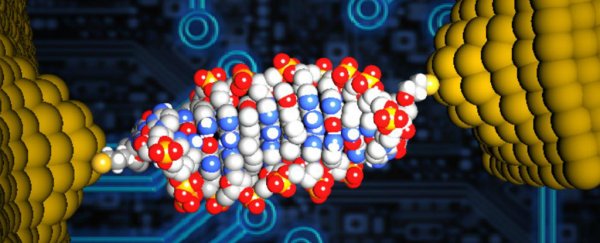Researchers have shrunk down one of the fundamental components of modern electronics, creating the world's smallest diode out of a single molecule of DNA. In fact, it's so tiny, you can't even see it using a conventional microscope.
Diodes are electronic devices that make it easy for current to flow in one direction, but not another. In other words, they're responsible for moving current around a lot of common electronics, and are printed by the millions onto modern-day silicon chips. But to increase the processing power of these chips, we need to make diodes a lot smaller, which is where DNA comes into it.
"For 50 years, we have been able to place more and more computing power onto smaller and smaller chips, but we are now pushing the physical limits of silicon," said lead researcher Bingqian Xu, from the University of Georgia. "Our discovery can lead to progress in the design and construction of nanoscale electronic elements that are at least 1,000 times smaller than current components."
When thinking about designing smaller diodes and electronics, researchers have long been focussing on using single molecules, since they're the smallest stable structure imaginable.
Following that line of thought, Xu and his team figured DNA would be a perfect candidate, seeing as it has a predictable structure, is diverse, and is also highly programmable.
But what they weren't sure of was whether it could control the flow of electric current, like a diode needs to. To be clear, no diode is perfectly efficient - in a perfect world, a diode would block 100 percent of current in one direction, and would allow infinite current flow in the other.
But in reality, today's diodes still let a tiny current pass back and forth each direction. Overall, what defines diode is that there's an imbalance in how they transmit current, and the bigger that imbalance, the better.
To get DNA to do this, the team took a single strand that was just 11 base pairs long (pretty tiny when you consider inside every cell of our bodies we have DNA strands with approximately 3 billion base pairs all curled up). They then added a molecule called coralyne into the helix structure, and connected the whole thing to a tiny electronic circuit only a few nanometeres long.
Surprisingly, the DNA turned out to be a pretty good diode, with the current flowing through the molecule 15 times greater for negative voltages than for positive ones.
"This finding is quite counterintuitive because the molecular structure is still seemingly symmetrical after coralyne intercalation," said Xu.
Although the DNA diode was impressive, it wasn't quite as efficient as other single-molecule diodes that have been created. But this one is a whole lot smaller than anything else out there, which means that you can pack more of them onto a chip and potentially create smaller and more powerful devices.
The team is now looking into how they can further improve the efficiency of the DNA diodes to get them to one day compete with silicon diodes. And the possibilities are pretty exciting - just imagine finally being able to have functional electronics built on the molecular scale. The future is looking bright.
The research has been published in Nature Chemistry.
